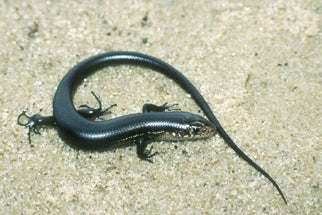SCIENTIFIC NAME:
Plestiodon anthracinus (Baird)
OTHER NAMES:
Scorpion.
STATUS:
Rare and infrequently encountered. Widely distributed, but limits of distribution incompletely known. Most records from Coastal Plain, but also documented from Southwestern Appalachians and Ridge and Valley. Some Alabama populations are P.a. pluvialis (southern coal skink) while others are intergradient with P.a. anthracinus (northern coal skink).HIGH CONSERVATION CONCERN.
DESCRIPTION:
A small to medium-sized (max. length up to 178 mm [7 in.]) lizard. As in other skinks, scales smooth, shiny, and overlapping. Sides of adults have a dark brown band bordered by narrow light stripes. Back tan to brown between dorsolateral light stripes, but lighter than the lateral band. Dorsum may be uniform, contain dark stripes or spots, or a light mid-dorsal line of less prominence than other light lines (Smith 1946). Differs from broad-headed skink, five-lined skink,and southeastern five-lined skinkin being smaller, having an undivided postmental scale (versus divided), and, in younger individuals, having dull blue as opposed to a bright blue tail. Differs from the ground skinkin being larger and having light stripes or traces of light markings on the upper lips; from themole skink in being larger, having proportionately larger legs, having light stripes extending the length of the body in adults, and having a brown tail (mole skinksin Alabama have a red or pink tail). Two subspecies, P. a. anthracinus and P. a. pluvialis, the northern coal skink and southern coal skink, respectively, occur in Alabama (Mount 1975). They differ in minor details of pigmentation and body scalation. (Bodies of young P. a. pluvialis may be almost uniformly black in color.)
DISTRIBUTION:
Occurs over broad region of eastern and central United States, from Lake Erie in New York southward to the Florida Panhandle and westward to eastern portions of Kansas, Oklahoma, and Texas. Both subspecies, but particularly P. a. anthracinus, occur in numerous disjunct, possibly relictual, populations. Within Alabama, the northern coal skink is found in the northwestern portion of state, where it shows evidence of intergradation with the southern form in the northwestern Fall Line Hills and on Sand Mountain (Mount 1975). Those from other areas of Alabama belong to southern subspecies. Latter known to occur in eastern Alabama only at two sites in RussellCounty, but has a more extensive distribution in the central and southwestern portions of the state.
HABITAT:
In northern Alabama, hilly sites with mixed pine hardwood forests. Typically encountered in mesic situations in rotting logs, under rocks, or in leaf litter, seldom far from streams. In the Florida Panhandle, occurs near swampy streams bordered by dense evergreen shrubs (black titi) and in adjacent pitcher plant bogs (Means 1992b). Likely will be found in similar habitats in extreme southern Alabama.
LIFE HISTORY AND ECOLOGY:
Knowledge is fragmentary. In New York, courtship and mating occur in late May (Smith 1946). Mating in Alabama observed in March (Mount 1975). Females lay a single clutch of four to nine eggs in late June and guard them in the nest, presumably until hatching. Upon hatching four to five weeks later, young are 21 to 23 millimeters (approx. one inch) snout-vent length. Apparently live several years, but little known about growth rates, survival rates, or social behavior. In Alabama, eggs from a nest discovered on 10 June hatched on 4 July. In another instance, a captive female laid four eggs on 21 April; hatching occurred on 29 May(Mount 1975).
BASIS FOR STATUS CLASSIFICATION:
Fairly widely distributed in Alabama, has been collected in recent years, but occurrence spotty and inadequately understood. Whether apparent absence from many suitable locations is real or an artifact of secretive behavior is unknown. Population densities, which have not seemed high in recent decades, appear to be decreasing. The Russell County population, if still extant, appears to be isolated from other known populations, and there also may be other sizeable gaps in the distribution.
Author:
D. Bruce Means






